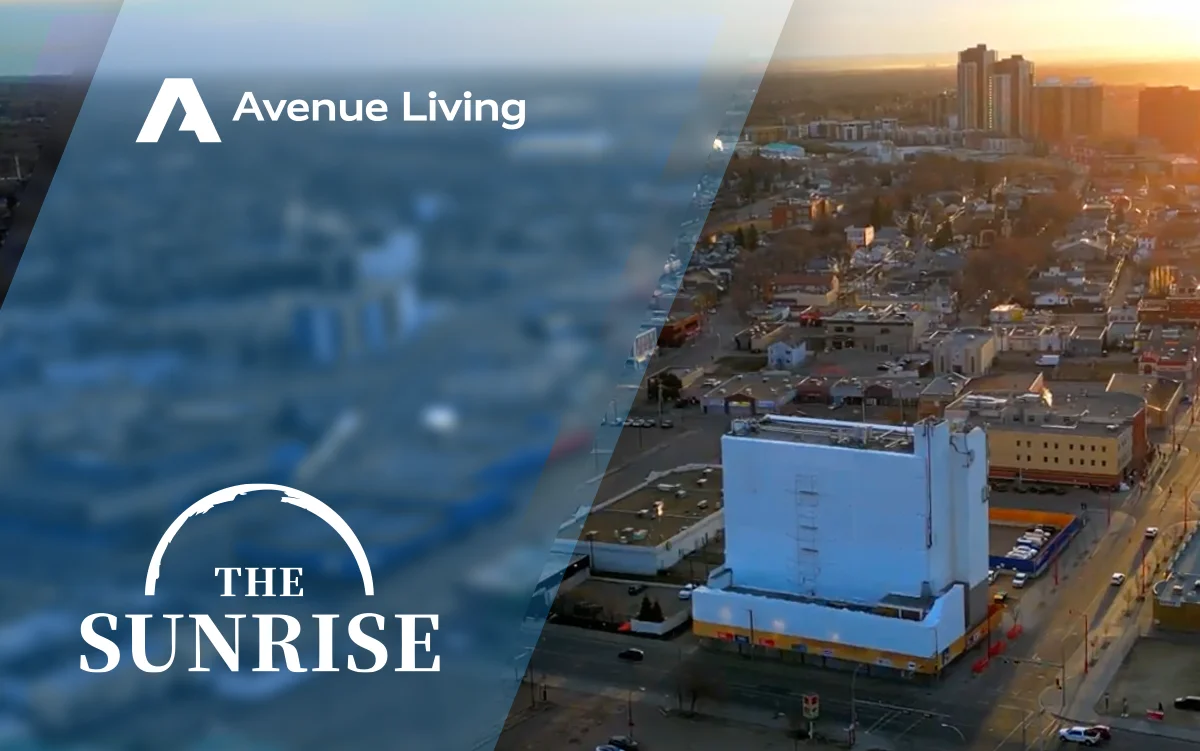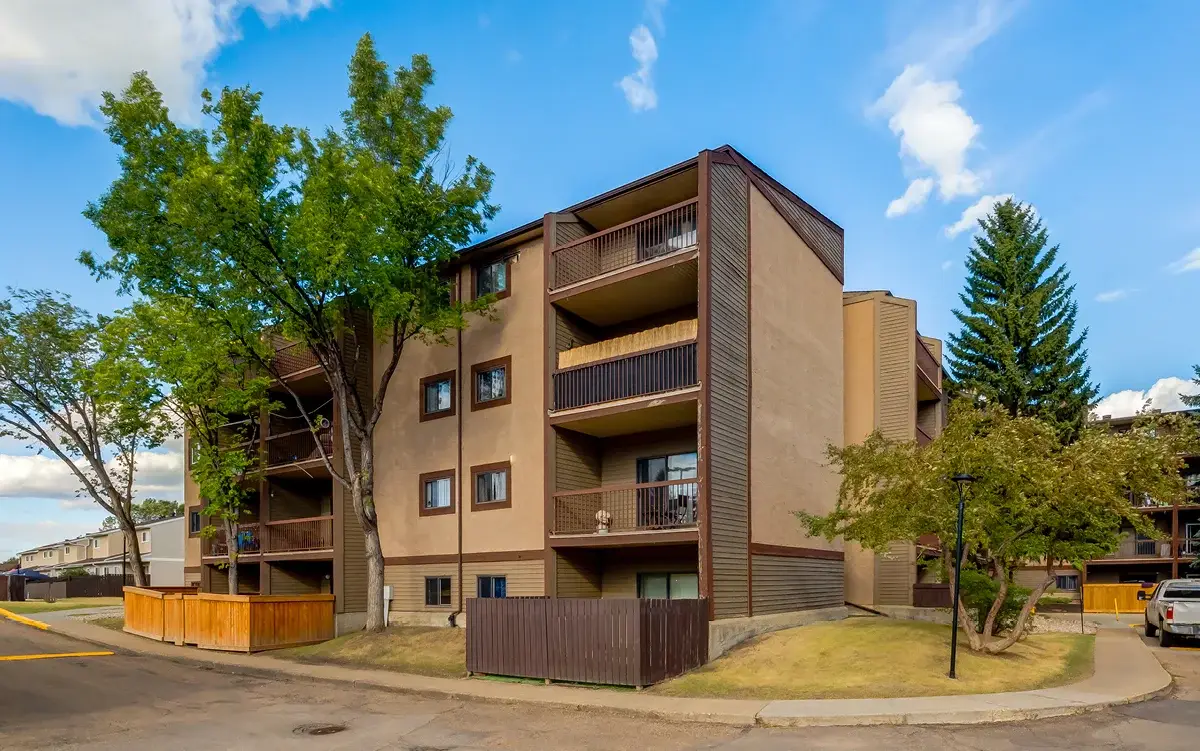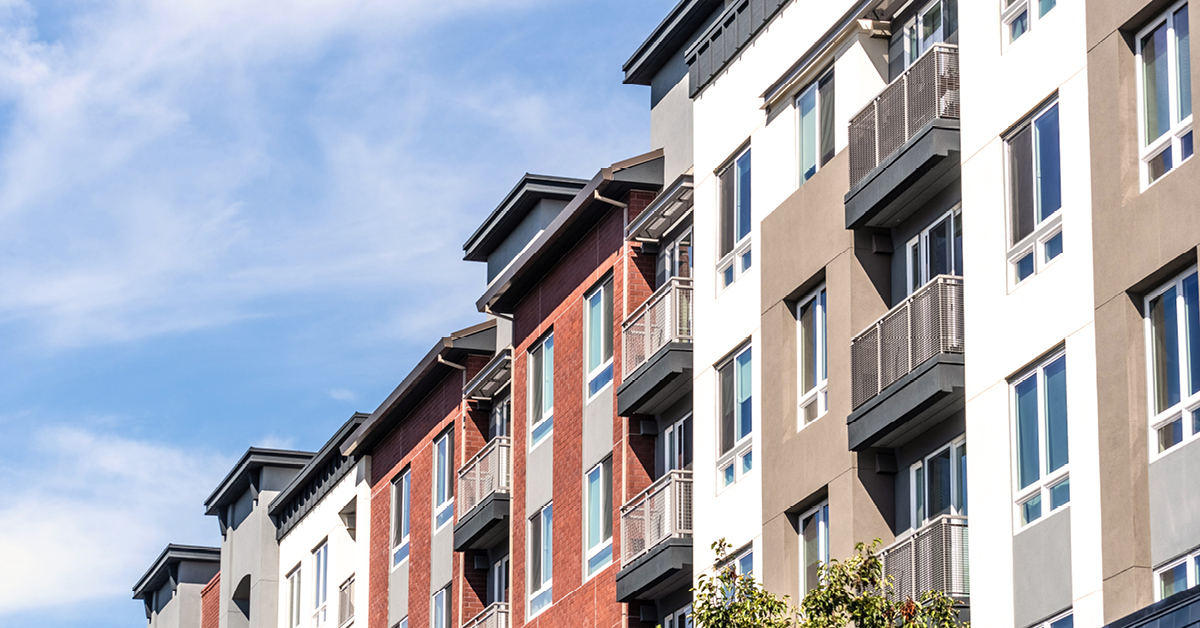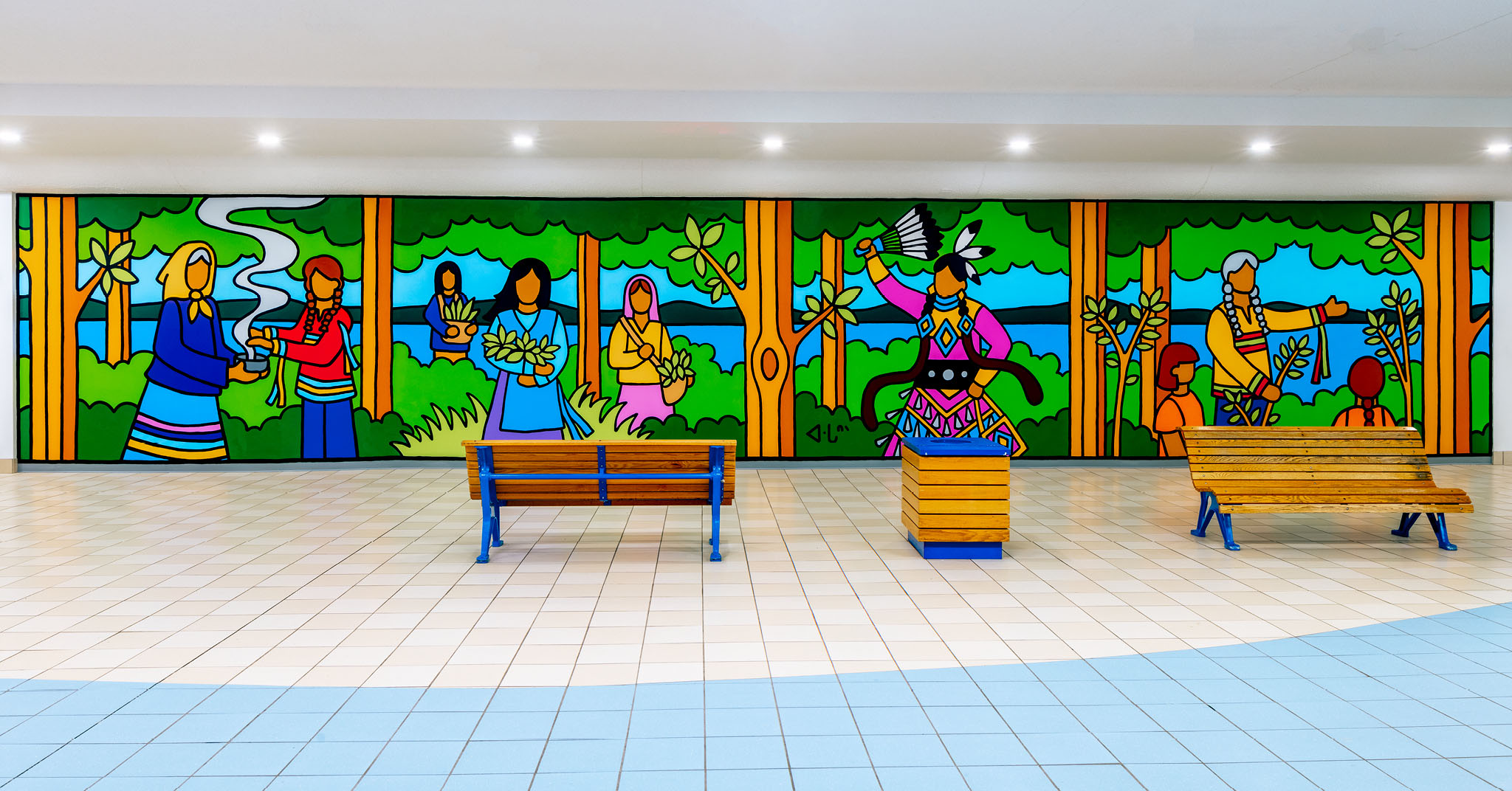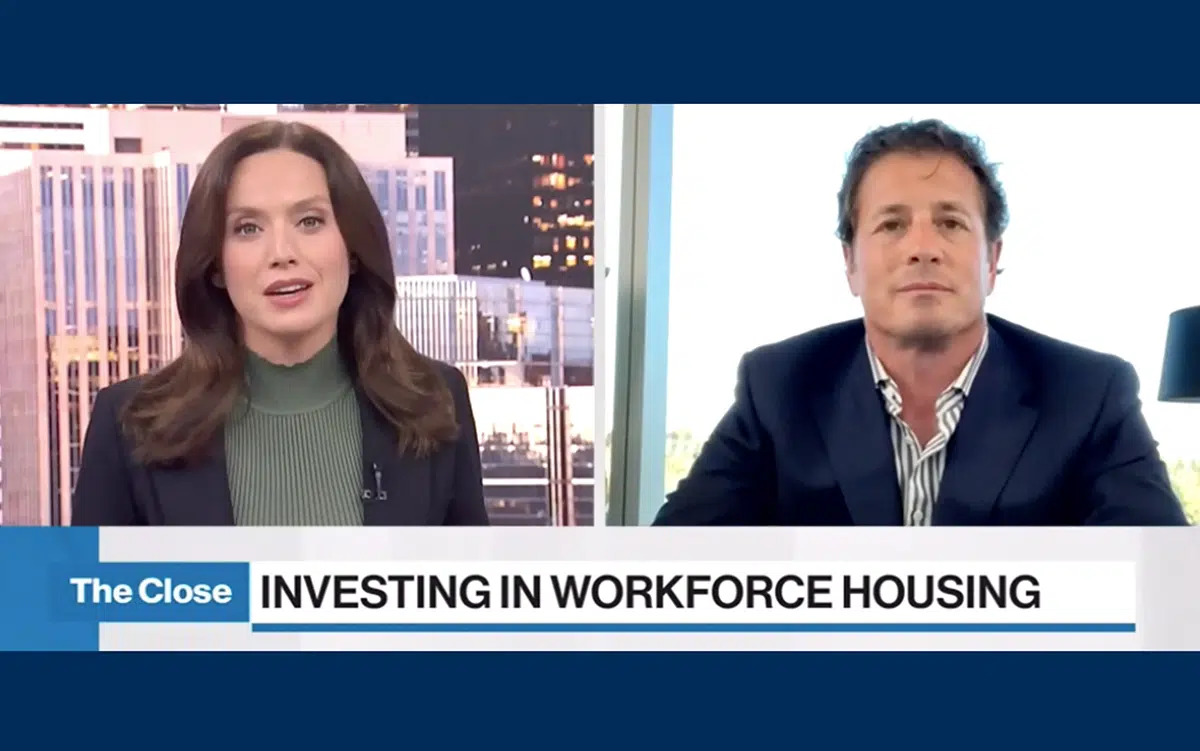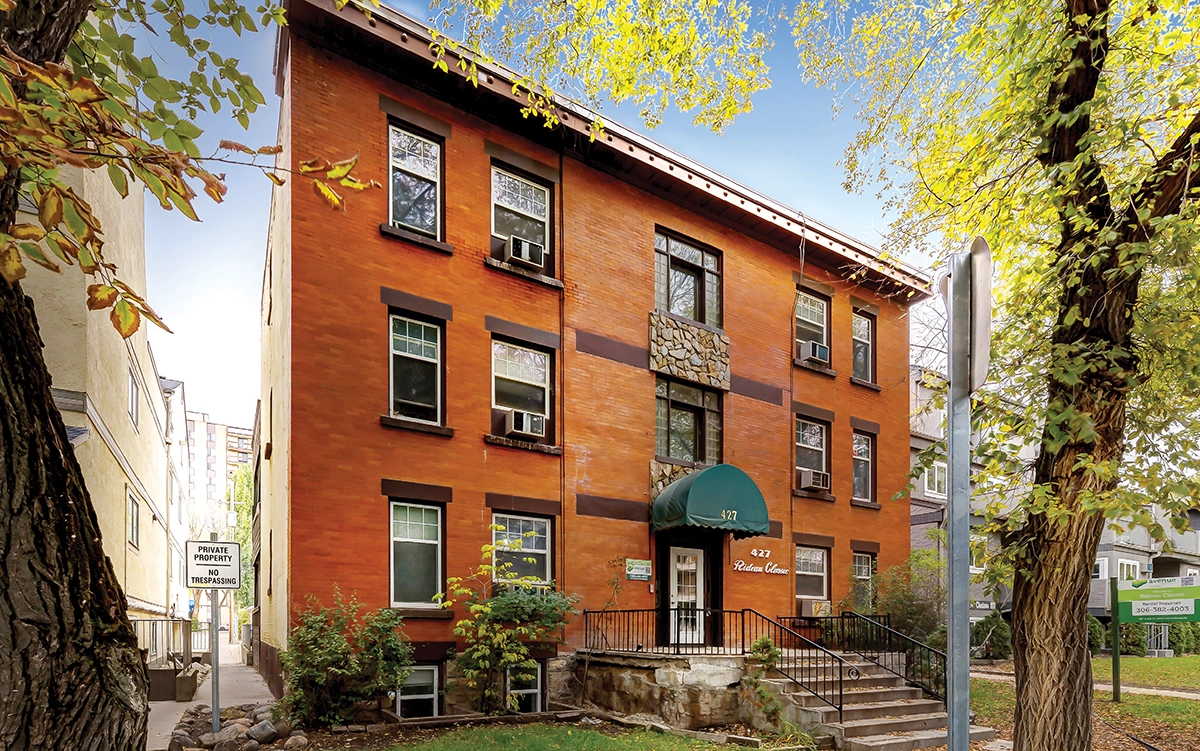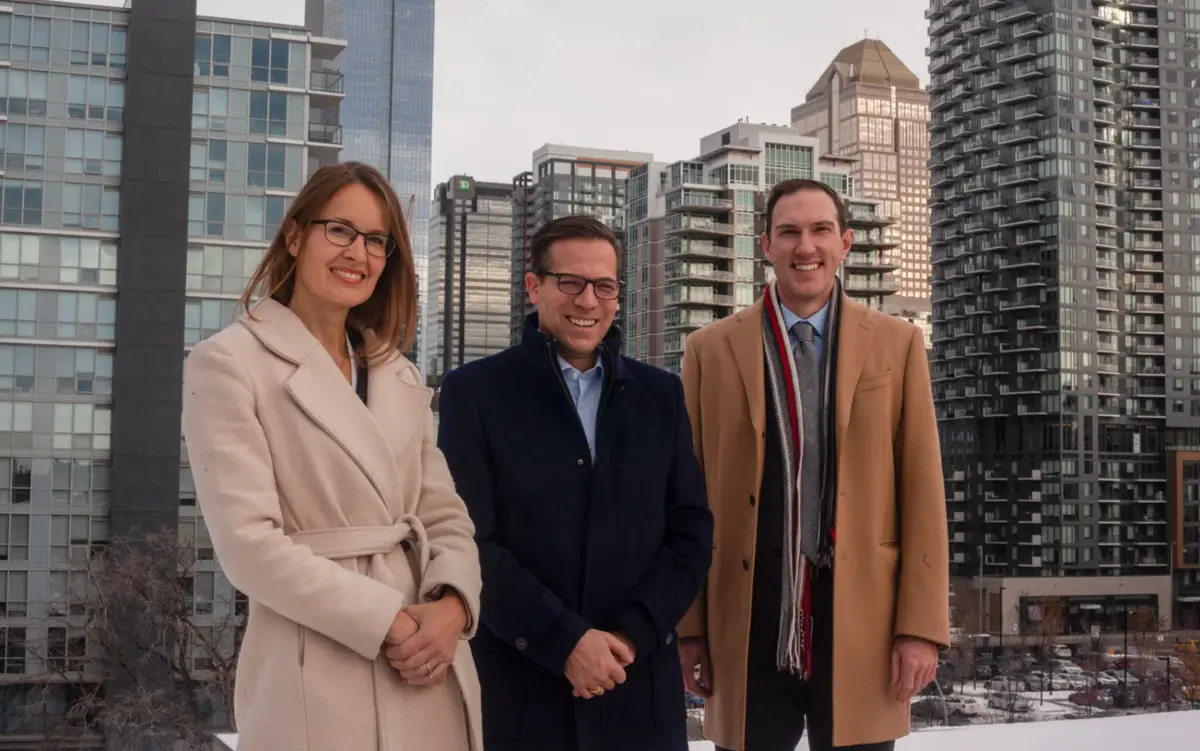The transformation of Edmonton’s The SunRise symbolizes a fresh start for the downtown community. Bringing life to 179 new homes in a centralized location supports an important demographic of Canadians including students, young professionals, and essential workers in their search for safe, comfortable housing.
Upgrades are aimed at reducing the carbon footprint of the building and showcasing the cultural heritage and vibrancy of the neighbourhood with a unique solar panel mural designed by local artist, Lance Cardinal.
The revitalized building is a key part of our broader commitment to sustainability across our portfolio.
The Benefits of Submetering in Multi-Family Residential
Rising energy costs and the environmental impacts of energy consumption are at the forefront of Canadians’ minds. Statistics Canada reported that Alberta’s electricity prices rose by 128% year-over-year in July. These increased costs, along with the environmental impacts around energy consumption, have prompted organizations and individuals to look for ways to reduce their utility usage.
Traditional methods of charging residents for utilities by including them in fees (based on square footage, for example) might seem straightforward on the surface, but it can end up costing both property owners and residents more.
Residential and commercial buildings in Canada account for 17% of our energy consumption. Reducing that consumption is a key part of the overarching strategy to reduce our greenhouse gas emissions and help meet the Government of Canada’s commitment to achieve net-zero by 2050.
Different Methods of Utilities Distribution
There are three main ways to deliver utilities to a residential unit in a multi-family property.
- Master meters: Traditionally, utilities have been delivered to a master meter, and the total cost of these services is split evenly between the units and included in each resident’s monthly rent. Every resident pays the same price, regardless of how much water or electricity they use each month.
- Individual unit meters: Some properties use individual meters in each suite, and utility hookups and pricing are managed directly by the resident. They assume the costs of access fees and other riders connected to their utility bill and are subject to rate fluctuations. In this case, property owners have no visibility into what the resident is using or how much they pay.
- Submeters: Properties with submeters receive water, gas, and electricity through a master meter, but also have a submeter in each unit to measure individual consumption. Residents pay the submetering company for their utilities, based on how much they use. The property owner might assume the access fees and the resident may have the benefit of a lower rate if the property manager has negotiated one with utility providers.
The Benefits of Submetering
When it comes to energy consumption, knowledge is power. With submeters in each unit, both residents and property owners have a deeper understanding of consumption habits and opportunities to reduce waste.
A clear picture. Individual submetering allows residents to see how much energy they use, and property owners can understand their residents’ usage. With a clear picture of consumption, property owners can make informed decisions about equipment maintenance and upgrades, finding ways to optimize the building’s energy use overall. In turn, residents can see their own consumption patterns, and make decisions accordingly.
Responsibility… and accountability. With submeters, residents are responsible for their own energy, heat, and water use rather than paying a portion of the bill for the entire building. They only pay for what they use, rather than what their neighbours might be consuming. This motivates residents to be mindful of their daily energy usage.
The potential for better rates. Some property owners, like Avenue Living, can negotiate lower bulk utility rates for their residents rather than a single customer could on their own. In addition, property owners might assume some or all of the access fees.
Environmental benefits through reduced emissions. Studies suggest that submeters can reduce a building’s energy consumption significantly — a study in New York revealed that submetering reduced consumption by 18-25%, while a building in Ontario recorded even bigger savings (approximately 40%). This is likely because residents can see their consumption and make choices to reduce it, and property owners can realize the tangible benefits of installing energy-efficient fixtures.
Increased efficiency and building value. The ability to monitor consumption also helps property owners and managers spot equipment failures or building inefficiencies. A spike in water consumption could indicate a leak, for example, or high energy use could flag the need for appliance upgrades. This insight allows the property owner to be proactive about maintenance, increasing the property value and comfort for residents.
Avenue Living’s Submetering Strategy
Avenue Living has transitioned several buildings to a submetered system. The submeters we have installed are certified by Measurement Canada, and the program is implemented through a certified third-party provider.
“Avenue Living still covers the cost of utilities in common areas and vacant units,” notes Daniel Klemky, Energy Manager at Avenue Living. “But with submetering we can now give residents the tools to take control of their own costs and be accountable for them. In many cases, we also give people the benefit of a much lower utility rate, due to our negotiations with the providers as part of our procurement strategy.”
The comprehensive insight we get from submetering will allow us to accurately measure the impact of our energy efficiency capital improvements (e.g., replacing a furnace or installing solar panels). And as we continue to upgrade our properties through the deep energy retrofit program, in partnership with the Canada Infrastructure Bank, submetering will play a crucial role in meeting the reporting and data collection requirements.
Submetering provides numerous benefits to both the resident and the owner and is becoming a common tool for property managers to quickly take control of energy consumption, and reduce emissions and operational costs.
This commentary and the information contained herein are for educational and informational purposes only and do not constitute an offer to sell, or a solicitation of an offer to buy, any securities or related financial instruments. This article may contain forward-looking statements. Readers should refer to information contained on our website at https://avenuelivingam.wpenginepowered.com/forward-looking-statements for additional information regarding forward-looking statements and certain risks associated with them.
Revitalizing Canada’s Housing Landscape: The Crucial Role of Retrofits
As cities across North America deal with a growing crisis in affordable housing, it is clear that the solution is not one-size-fits-all and it involves more than simply building new stock. The Canada Mortgage and Housing Corporation (CMHC) estimates that Canada needs to add an additional 3.5 million units, above the current build pace, by 2030 to restore housing affordability. With rising interest rates and inflated costs, the ability to own a home is becoming out of reach for many. Further, there’s a concern that there are not enough rental properties for the population who need them. Add to that the constraints of building permits, labour shortages, and spiralling costs for developers, it is essential to look at other ways to support individuals and families. One such approach is to retrofit existing housing stock.
While building new homes is essential and necessary, reinvigorating existing housing is equally as important to ensure that people have safe and comfortable homes and to curb greenhouse gas emissions. With approximately 90% of Canada’s existing multi-family housing built before the year 2000, many of these buildings are reaching an age where renovations and upgrades are required to improve overall energy efficiency and quality.
In a recently published CMHC report, it states that in order to achieve housing affordability, there must be a “variety of housing options available” including those for both ownership and rental, a mix of single-family and multi-family homes, and new builds and retrofits. “Partnerships and innovation are needed in all parts of the housing system,” says the report.
Strategic Retrofits Are Key
In 2022, Avenue Living embarked on a landmark partnership with the Canada Infrastructure Bank and other key industry partners to retrofit approximately half of its multi-family portfolio. The initiative demonstrates a solid business case for the property management industry to make widespread changes.
Catalys, an energy and sustainability program designer, and one of the partners we have engaged to help achieve our deep retrofit goals, understands exactly what a difference these improvements can make. The firm has a track record of working with a variety of enterprise clients to help reduce their environmental impact by designing energy and sustainability programs, either through retrofits or improved processes. Catalys employs a data-driven technology and AI analysis model that helps property owners maximize the environmental benefits of retrofits and other investments.
“The environmental impacts of demolishing an existing building and replacing it with a new development can be significant,” says Luke Ferdinands, CEO of Catalys. “Both deconstruction and construction are waste-intensive, and a deep refurbishment of an existing building cuts operational carbon emissions — without the emissions associated with building new. Approximately 60% of embodied carbon emissions are associated with the sub-structure, frame, upper floors, and roof of a building. A deep retrofit will generally retain these elements, meaning on average, the carbon footprint of a refurbished building is about half that of the newly-built replacement.”
The firm has provided consultation and support to Avenue Living throughout the project, from feasibility studies to ongoing program management. As the retrofits scale, Ferdinands and his team will continue to assist with managing complexity, verifying performance, and measuring success through data tracking and analysis.
Benefits of Retrofits, from the Bottom (line) Up
Retrofitting can be completed much more efficiently than new builds, which often require lengthy schedules due to permitting and other considerations. “In Canada, a new building can take well over two years to be completed”, says Ferdinands. “Retrofits can take far less time — and they can benefit from streamlined processes that some municipalities have in place to expedite the permitting for such projects.
“When executed properly, deep retrofits can deliver buildings that appear to be totally different — they look newer and with a more modern aesthetic,” continues Ferdinands. “But more importantly, the resident experience of living there is also significantly improved.”
Studies show that living in an energy-efficient or “green” building improves residents’ overall quality of life. Not only are they living in more comfortable spaces, but they experience better health through upgraded lighting and balanced heating and cooling. In many cases, these buildings can become a vital part of the social fabric of a community — as Canada’s Green Building Council (CGBC) notes, “everyone benefits when community members have access to healthy, affordable housing and when communities are resilient and can withstand extreme weather events.”
Not all retrofits involve turning over the entire building; some upgrades can be quite simple, yet still achieve positive results. Less complex upgrades, such as boiler replacement or rooftop solar PV installations, mean residents can remain in place as retrofits occur with minimal disruption in their daily lives. “From a continuity perspective, it’s really important to make these upgrades as seamless as possible to minimize the impacts to the people who have made that building their home,” says Ferdinands.
These retrofits bring aging stock up to today’s standard, but they also ensure buildings are optimized for the future. “We’re making these buildings much more resilient,” says Ferdinands. “With more extreme weather — hotter summers, colder winters, and wildfire smoke – these upgrades really tighten up the building. We’re redoing roofs, adding insulation, improving windows, all of which help the building perform better in different conditions.”
Social Benefits
Ensuring existing buildings remain comfortable, desirable, and affordable places to live helps preserve communities. The ability to live in established neighbourhoods close to transit routes, schools, employment, and amenities offers a better quality of life for renters and encourages neighbourhoods to remain vibrant. Residents who are happy with their neighbourhood and comfortable in their homes are likely to stay, bringing added economic stability to a community. In addition, retrofitted, affordable rentals support a growing and stable population, and encourage local economic growth as working renters, seniors, and children all participate in their community, supporting nearby businesses and services.
“Renewing these older buildings is vital for communities,” says Gabriel Millard, SVP, Capital Markets – Equity & Research, who notes that many are often demolished and replaced with larger, more expensive rental properties. “In Canada, where we have fewer and fewer options at the less costly end of the rental spectrum, renewal helps extend the lifespan of these buildings so they can keep housing families. We’re making sure that important piece of the rental puzzle stays on the market.”
Retrofits for the Future
As we deal with two major challenges — housing affordability and environmental impact — it’s becoming clear that retrofits to existing buildings are a key part of the solution. Through a strategic and sustainable implementation, property managers can bring buildings up to date without losing occupancy. At the same time, residents can reap the health, social, and financial benefits of having a comfortable, affordable place to live in an established community.
This commentary and the information contained herein are for educational and informational purposes only and do not constitute an offer to sell, or a solicitation of an offer to buy, any securities or related financial instruments. This article may contain forward-looking statements. Readers should refer to information contained on our website at https://avenuelivingam.wpenginepowered.com/forward-looking-statements for additional information regarding forward-looking statements and certain risks associated with them.
Walking the Talk: How Avenue Living Brings Sustainable Investing to Life
As a major property owner and operator across North America, we have the unique opportunity to make a significant positive impact and set a great example within our industry. Avenue Living’s CPO, Max Graham, joins Wealth Professional to discuss how we’re focused on making ESG a strategic and repeatable piece of our business.
Read more about how we’ve integrated ESG principles into our daily operations.
Building a Culture of Safety at Avenue Living
A happy workplace is a productive workplace. But did you know that safety is a major contributor to employee satisfaction? Workplace injuries carry a significant impact, impacting tens of thousands of workers every year, affecting their families, co-workers, and communities. In 2022, Canada’s Worker’s Compensation Board (WCB) reported there were 4.33 injuries per 100 workers in Canada.
One of Avenue Living’s core values is “Duty of Care,” and while we often talk about it in relation to our residents, customers, and our investors, it also applies to our workforce. That duty manifests itself in creating an environment that seeks to minimize risks for every member of our team, whether they work in our offices or out in the field.
Safety is more than a set of policies and procedures, it’s part of an organization’s culture, and it flows from the top down.
“Safety is connected to everything,” says John Price, Senior Vice President Health, Safety, and Environment (HSE). “The better your safety culture, the more engaged your teams are. Studies show that organizations who have highly engaged employees can reduce safety-related incidents by up to 70 per cent.”
An article published by the Harvard School of Public Health notes that “engaged workers are more likely to be aware of their surroundings and best safety practices making them more likely to take steps to protect their co-workers.”
This engagement also has a ripple effect. “Everyone wants to feel that they’re valued,” says John. “It’s true that happy employees are the best employees. It’s a key ingredient in building the highest performing teams.”
In practical terms, facilitating safe work environments results in bottom-line benefits: reduced absenteeism, better employee retention, lower insurance costs (through reduced claims and a better safety record), and better overall performance. While there’s no way to eliminate risk completely, a positive safety culture increases trust throughout an organization — both with employees and their peers, and between employees and management, reducing disruptions to business.
Avenue Living’s Culture of Safety
“We’re focused on putting the tools for safety in people’s hands before they start work,” says John. Those tools include high-tech solutions but also plans and policies, training, and an organization-wide mindset that prioritizes everyone’s well-being. “Most workplace injuries are preventable when we’ve adequately equipped our teams with the knowledge, solutions, and planning necessary to carry out their jobs safely and effectively.”
We achieved our Safety Certificates of Recognition (COR) from the Alberta government starting in 2020, which requires third-party audits of safety practices, and we’ve implemented various technological tools to help keep our remote workers safe, track incidents, and monitor hazards. Software such as SitePhotos allows us to share visual records of maintenance jobs, and the ClearRisk application helps us track hazards and document risk mitigation. For lone workers, SolusGuard provides an extra layer of security via a panic button and app that prompts regular check-ins.
Always Moving Forward
But technology is only part of the story. A culture of safety ensures that everyone in the organization, from the top down, is committed to preventing incidents and putting barriers in place so when an incident occurs, no one gets hurt. Humans make errors and it’s important that, as a company, we work together to build capacity around these situations. “It’s how we grow and improve. There’s no better teacher of how to make work safer than those who perform the tasks,” says John.
Continuous improvement is a cornerstone of our organization, and we’ve taken a closer look at how our HSE team is structured and found a way to best serve the diverse needs of our different business units.
“We’re creating some bench strength and giving each team dedicated specialists,” says John, who notes that the restructuring was in response to hearing different business units’ needs. Now our self-storage, property management, and other areas have their own single point of contact with the safety team. This structure allows our safety specialists to develop deep knowledge of each business and work closely with the team to identify challenges and create solutions. This is key to a proactive safety culture.
Over the past year, we have also developed more robust emergency plans. For example, in March 2023, we launched an emergency response plan across the organization that outlines safety procedures for potential risks.
Across our organization, we’re developing a robust incident command system to help our teams manage emergencies such as extreme weather events. This system provides a platform for how we respond and recover from major events that affect our customers, teams, and assets.
Additionally, management performs regular site visits. “Being on-site is the best way for them to understand the safety requirements in our day-to-day operations,” says John. It also allows opportunities for the entire team to connect in person, strengthening trust and opening the lines of communication.
All these efforts serve to keep us — and the communities in which we work — safe. And they have an added benefit. As a customer-centric organization, taking care of each other allows us to focus on the thing that sets us apart: delivering superior service to our residents and customers across North America.
This commentary and the information contained herein are for educational and informational purposes only and do not constitute an offer to sell, or a solicitation of an offer to buy, any securities or related financial instruments. This article may contain forward-looking statements. Readers should refer to information contained on our website at https://avenuelivingam.wpenginepowered.com/forward-looking-statements for additional information regarding forward-looking statements and certain risks associated with them.
Multi-Family Retrofits: The Case for Going Green
In June 2022, Avenue Living and the Canada Infrastructure Bank (CIB) joined forces to commit $162 million towards deep retrofits across our Canadian portfolio. The partnership will fund upgrades to 220 residential buildings, touching approximately 6,700 homes and helping lower the carbon emissions for nearly half of our Canadian portfolio.
As a key pillar of our ESG efforts and overall strategy, Avenue Living has always made responsible and impactful capital improvements — for example, installing a better-insulated roof, higher-efficiency windows, or a new boiler. These energy conservation measures (ECMs) extend the life of the asset and make living spaces more comfortable in summer and winter.
Our portfolio spans a region with some of the coldest weather in North America, and these upgrades help increase energy efficiency. A better-insulated building envelope, for example, keeps the building temperature more even year-round and allows heating and cooling systems to work more effectively. Upgraded high-efficiency HVAC systems, paired with better-insulated building envelopes, help reduce consumption.
In 2020, commercial and residential buildings accounted for 17 per cent of Canada’s GHG emissions (excluding construction and building materials, which pushes the number to 30 per cent). The Government of Canada is committed to reducing carbon emissions to below 45% of 2005 levels by 2030 and reaching net-zero by 2050 — and estimates that, to meet that goal, Canada needs to retrofit 600,000 homes and 750 million square feet of commercial space per year between now and 2040 to meet those commitments.
Avenue Living is doing our part while paving the way to setting a new standard in the multi-family industry. As an open-source advisor and collaborator, we are sharing how these retrofits can benefit investors, residents, and our communities at large. Our partnership with the CIB aims to reduce emissions from buildings in the program by 50 per cent, and pilot projects are already underway.
CHOOSING ENERGY CONSERVATION MEASURES (ECMS)
Retrofitting buildings to create the most energy savings is based on careful analysis, energy audits, and a well-developed strategy for capital improvements. As part of our current acquisition strategy, Avenue Living systematically determines which capital improvements will be the most impactful for each property. Deep energy retrofits are no different.
Before a property can be included in the CIB retrofit program, it must meet Investor Ready Energy Efficiency (IREE) Certification. IREE is a global framework that signals a building has undergone appropriate due diligence and the retrofit projects have been developed by qualified professionals who adhere to a series of protocols for assessing risk, comparing savings, and evaluating opportunities. This third-party certification reduces costs for transactions, capital, and due diligence and increases investor confidence through reliable and consistent projections.
Baselining is essential to determining the viability of any retrofit project, and as part of IREE protocols, our buildings have undergone multiple energy audits. When we examined our portfolio in search of the most impactful ECMs, we discovered our larger properties — those with more than 24 units — presented our best opportunity to reduce GHG emissions. Energy audits have also revealed that wood-frame buildings can be further optimized compared to brick or concrete buildings, which are already quite efficient. In addition, we closely evaluated other aspects of the building’s mechanical operations and construction for ways to increase efficiency — roofs, boilers, and exterior cladding, for example.
“As we were going through the program details, we looked at a number of factors to determine if a building would be a good candidate for upgrades, for example, will the improvements offset enough energy and emissions to be financially viable, or is the building equipment old or inefficient,” says Daniel Klemky, energy manager at Avenue Living. “If building equipment is reaching the end of its useful life, there may be an opportunity for us to modernize that property in a cost-effective way.”
Our retrofits include:
- Upgraded heating, ventilation and cooling (HVAC) systems, which allow us to heat and cool buildings more efficiently and keep temperatures even throughout the property
- An upgraded building envelope and roof, which improves insulation, eliminates the possibility of pipes freezing and improves aesthetics
- Triple-glazed, high-efficiency windows, to reduce heat loss (or gain)
- Low-flow water fixtures, to reduce water consumption and provide a better experience for residents
- LED lighting and more efficient fixtures, for brighter, more effective lighting in common areas
- Solar panels, where applicable, allow properties to generate their own power, reduce consumption, and offset operational costs
Implementing these retrofits requires coordination — and manpower. Our plan has incorporated a phased approach, which allows us to make as many updates as possible without overwhelming the trades in each city. This perfectly illustrates the combined benefit of environmental projects: job creation, and the need for expansion in the sector. Canada’s Green Building Council estimates that by 2030 the opportunities for growth in the green building sector could account for approximately 1.5 million jobs and contribute $150 billion in GDP.
“It is difficult to retrofit multiple buildings in a single market at one time,” says Ward Woolgar, senior vice president, capital investment at Avenue Living. “We’ve planned out our retrofits with projected schedules and dates to make sure we have the tradespeople we need available at each phase to minimize delays.”
The solar project slated for Wetaskiwin Mall, for example, requires extensive work on the roof. “It’s not as simple as just putting solar panels on top of the existing structure,” says Klemky. “There’s a great deal of work that has to happen to the roof first, such as detailed design, structural reinforcement, electrical capacity considerations, and regulatory restrictions.” The mall’s solar retrofit, however, will also account for the biggest reduction in emissions.
BENEFITS BEYOND EMISSIONS REDUCTION
While reducing consumption and emissions is our primary goal, we know that these building improvements have other benefits for residents. As an active property manager, we recognize that happy residents stay in their homes for longer, and these upgrades will enhance the comfort and livability of their rentals. Studies show North Americans spend approximately 90 per cent of their time indoors, so air quality, temperature, and lighting are more important than ever.
These renovations require minimal disruption to residents’ lives or schedules, and in most cases happen outside the suites. Although retrofits like window replacement or upgrading water fixtures do require apartment entry, these jobs can be completed in just a few hours, like any regular maintenance task. That said, any construction work in a building has an impact on its occupants, and we’ve developed a plan to communicate with our residents early and often to ensure they understand the work schedule.
“These updates will have a noticeable effect,” says Woolgar. “For example, our upgrades to HVAC systems will mean there’s more even heating throughout the building, so we’ll avoid the problem with overheated hallways and common areas that a lot of apartment buildings have. New windows and fixtures will also mean residents can enjoy more even temperatures in their suites, better water flow and lighting, and improved aesthetics.”
A GREENER FUTURE FOR MULTI-FAMILY
The United Nations estimates that 80% of the buildings in cities today will exist in 2050. Reducing emissions through deep-energy retrofits is key to ensuring Canada — and the world — meets sustainability targets. For Avenue Living, the benefits of this retrofit project are very close to home: we see these retrofits as an opportunity to demonstrate to the industry what is possible. We aim to create a portfolio of properties that provide residents with safe, affordable, comfortable, and modern homes — ones that are well-equipped for a low-carbon future.
This commentary and the information contained herein are for educational and informational purposes only and do not constitute an offer to sell, or a solicitation of an offer to buy, any securities or related financial instruments. This article may contain forward-looking statements. Readers should refer to information contained on our website at https://avenuelivingam.wpenginepowered.com/forward-looking-statements for additional information regarding forward-looking statements and certain risks associated with them.
Renters Have Stepped Up Efforts to Address the Housing Crisis — It’s Time for Property Managers to Do the Same
At the heart of our business model lies a strong commitment to serving our customers. We’re keenly aware of market changes and take proactive steps to ensure we’re meeting the wants and needs of the workforce housing demographic. Our approach sets us apart from other asset managers in the industry and has allowed us to build lasting relationships with our residents.
Investing and Connecting with a Community: Wetaskiwin Mall’s New Mural
Inclusivity can take many forms — the people who make up an organization’s team, the causes they support, and the principles they operate under. But it can also take the form of representation in other ways like in the case of Wetaskiwin Mall, an exciting piece of original art, painted by a local, renowned Indigenous artist.
As property owners and operators, we know our investments have an impact on the people who live and work in the communities in which we operate. We invest in spaces — multi-family homes and commercial space — that people develop deep connections with. The mural at Wetaskiwin Mall aims to showcase the culture of the community and evoke the theme of “Healing Medicine.”
Collaborating with a Local Artist
Painted by distinguished Indigenous artist Lance Cardinal, the 50-foot mural in the north wing of the mall symbolizes many ways of healing: ceremonial, medicinal, cultural, and healing through dance — a fitting subject given its location right outside an Alberta Health Services office and the Care Gateway Clinic. Cardinal painted the mural over ten days, with the help of an assistant.
Cardinal, from Big Stone Cree First Nation, is an artist and entrepreneur on the rise. In 2022, he collaborated with the Edmonton Oilers to write and produce the team’s new land acknowledgement and design their Turtle Island logo, which helped raise funds for Edmonton charities, while being one of the most popular and beloved alternate designs in the team’s history. His shoe collection with Kunitz Shoes, an Edmonton-based company, is set to launch this year and is currently on display at the Royal Alberta Museum.
Wetaskiwin, Alberta, which is 70 km south of Edmonton, is a community of around 13,000. The city is located on Treaty Six territory, bordered by two of the four Maskwacis First Nations — the Ermineskin and Samson Cree Nations — and serving two others — the Louis Bull Tribe and Montana First Nation. Wetaskiwin has rich Indigenous history; its name (which means “the hills where peace was made”) is a direct reference to the outcome of a battle between the Cree and Blackfoot.

Bringing People Together
Our strategy with Wetaskiwin Mall has always been to create a “community hub,” a place that provides customers with the essential services they need all in one place. In addition to national retailers and locally-owned stores and services, the mall is also home to Alberta Health Services, a pharmacy, medical clinic, optometrist, and more. Avenue Living has invested in Wetaskiwin for over a decade, with a presence that includes 401 multi-family units and 158,000 square feet of commercial space. In keeping with a key tenet of our strategy as an active manager, we have developed a deep understanding of the market and its residents. Since acquiring the shopping center in 2017, Avenue Living has carefully curated a roster of retailers and services that reflect the needs and wants of area residents.
“You don’t usually see local art in a retail environment like this,” says Slava Fedossenko, Director, Commercial Asset Management for Avenue Living, “but we wanted to create something that reflects the culture of the community.”
Avenue Living is immensely proud of our partnership with Lance Cardinal and the finished mural. While it is one of the first projects of its kind for us, we have plans to ensure it is not the last, and we look forward to working with local artists in other communities to showcase the places our residents and customers call home.
Read more about Lance Cardinal and this exciting project in The Wetaskiwin Times.
This commentary and the information contained herein are for educational and informational purposes only and do not constitute an offer to sell, or a solicitation of an offer to buy, any securities or related financial instruments. This article may contain forward-looking statements. Readers should refer to information contained on our website at https://avenuelivingam.wpenginepowered.com/forward-looking-statements for additional information regarding forward-looking statements and certain risks associated with them.
International Women’s Day 2023
International Women’s Day provides an opportunity to reflect on the progress made toward gender equality — and the work that still needs to be done.
We believe every employee should have the opportunity to reach their full potential and are committed to creating a culture of respect, inclusivity, and diversity. By providing equal opportunities for all employees, we’ve created a business that’s stronger and better positioned to serve our customers and communities.
Hear firsthand from our team about how they’ve navigated leadership roles and fostered inclusivity.
Continuous Improvement: How Focusing on Customer Satisfaction Also Boosts Employee Morale
“In everything we do, we focus on our residents and customers first.” This is a common phrase used by Avenue Living’s Chief Investment Officer, Jason Jogia, and a sentiment that reverberates throughout the organization. This laser focus on the customer drives our investment strategy, our approach to service, and our operations as a whole.
Since 2006, we’ve learned that superior customer service requires ongoing adaptation from our team. Employee satisfaction and customer satisfaction are uniquely linked; when a process is smooth and easy for our leasing specialists, maintenance associates, or regional portfolio managers, it usually means it’s convenient for our customers.
“We centre our operations around the customer and employee experience. We want to make tasks easier for everyone,” says Winford Rader, Vice President of Continuous Improvement. “Creating efficiencies means doing our research, evaluating the tools we’re using, and aligning our teams to best serve our customers.”
Avenue Living’s Continuous Improvement department develops better processes for our team and customers. Officially formed in 2019, the group of almost 20 includes business analysts, data analysts, and operational efficiency experts. They break procedures down and examine how each component can be streamlined. And sometimes, they uncover simple, time-saving solutions to a host of challenges.
The property management industry is in the middle of significant change, as new technology and changing customer needs push managers to consider how to attract and retain residents. The Entrata 2022 Renter’s Report notes that 62 per cent of renters surveyed prefer interaction with a real person — and it builds greater trust. Renters listed responsiveness, ability to give feedback (renter input), and face-to-face interaction as the top items they wanted their property manager to improve.
For Avenue Living, delivering industry-leading customer service has been a key differentiator from the very beginning. Providing a positive experience means re-examining our processes and adapting, whether it’s improving our response time to maintenance calls (99 per cent of which are fully resolved within 1.85 days) or making showings, rental applications, or the leasing process easier.
Sometimes the solutions to our biggest challenges lie in the smallest details.
Using data to drive improvement
The Continuous Improvement department looks at data from numerous sources, such as Google My Business, and Yardi Voyager to consolidate one “curated, validated, and trusted source of data.” With this one source of truth in hand, teams across the Avenue Living platform can begin to see where processes are performing well and where improvements can be made.
“It’s easy to get hung up on how we’ve historically done things,” says Winford Rader. “But sometimes asking the right questions and understanding the end result can help us arrive at an improved destination sooner.”
Humanity + Technology
The insight we get from front-line interactions between our residents and our Regional Portfolio Managers (RPMs), leasing specialists, and maintenance associates has led to simple solutions that can have a big impact. For example, improving the outcome of the leasing process by tailoring appointments to times when potential residents are most available, or creating tools that allow a smoother application and signing process.
The Continuous Improvement team works in tandem with business units across the organization to arrive at solutions, rather than prescribing them. The team gathers data and provides analysis that allows each group to determine a feasible endpoint. This collaborative effort creates greater buy-in and personal investment in the results.
Smoothing out these processes often has reduced costs by eliminating redundant efforts. Innovation that allows our team to save even minutes a day has a significant impact throughout the calendar year. Coupled with responsive customer service and a focus on retention, it has helped us create value for our investors, today and in the future.
The Continuous Improvement team allows us to think strategically and see how our end-to-end customer service processes work together. As the market evolves and resident demands change, we’re able to respond more effectively and work toward a shared vision that serves our customers, employees, and investors.
This commentary and the information contained herein are for educational and informational purposes only and do not constitute an offer to sell, or a solicitation of an offer to buy, any securities or related financial instruments. This article may contain forward-looking statements. Readers should refer to information contained on our website at https://avenuelivingam.wpenginepowered.com/forward-looking-statements for additional information regarding forward-looking statements and certain risks associated with them.
We’re Focussing on Housing Affordability for Essential Workers: Avenue Living CEO
Building our strategic, stable, and defensible business requires extensive research and planning, as well as a clear understanding of our target demographic — workforce housing.
Avenue Living CEO, Anthony Giuffre, joined Jacqueline Hansen of The Close to discuss the 16 years of experience behind the organization’s growth from an Alberta-based business to a significant property owner-operator across the North American Heartland. He addresses affordability, their asset and market selection process, and the demand outlook.
This commentary and the information contained herein are for educational and informational purposes only and do not constitute an offer to sell, or a solicitation of an offer to buy any securities or related financial instruments. This article may contain forward-looking statements. Readers should refer to information contained on our website at www.alamstg.wpenginepowered.com for additional information regarding forward-looking statements and certain risks associated with them.
Avenue Living Wins Gold in 12th Annual Best in Biz Awards
The organization demonstrates a commitment to innovation, sustainability, and customer service excellence.
Calgary, Alberta – December 7, 2022 – Avenue Living Asset Management (“Avenue Living”) has been named a gold winner for Company of the Year – Canada by the Best in Biz Awards.
By investing in the everyday and adding value to its properties, expanding the organization’s footprint, and focusing on its workforce and brand advantage, Avenue Living has demonstrated the ability to be defensible, stable, and strategic in its daily operations and long-term vision to drive value for its customers and stakeholders.
The 12th annual Best in Biz Awards saw more than 700 entries from public and private companies of all sizes and represents diverse industries and regions in the U.S. and Canada, ranging from global brands to the most innovative start-ups and local companies. This year’s judges highlighted the winning companies’ visionary leadership, innovative strides in the use of new technologies, and the adoption of workplace best practices. Many winners also continued to invest in environmental and corporate social responsibility programs.
“We’re incredibly proud of the resilience our team and organization showed throughout 2022,” says Jason Jogia, chief investment officer of Avenue Living. “Being named a gold winner for Company of the Year by the Best in Biz Awards is a testament to our team’s commitment to excellence and sustainability in the multi-family industry.”
Since the program’s inception in 2011, winners of the Best in Biz Awards have been determined by independent judging panels assembled from some of the most respected national and local newspapers, TV and radio outlets, and business, consumer, technology, and trade publications in North America. The 2022 judging panel included, among others, writers from AdWeek, Computerworld, Forbes, The Globe & Mail, Inc., The Oregonian, and Portland Tribune.
“The depth and breadth of this year’s nominees in Best in Biz Awards – and especially the winners – demonstrate savvy business acumen among the leadership and represent the type of entrepreneurship powering today’s economy,” said Dustin Klein, Smart Business, judging his first Best in Biz Awards competition.
After reviewing hundreds of submissions, the judges were impressed with Avenue Living’s growth, both in terms of employee numbers and assets under management. They highlighted Avenue Living’s focus on serving all stakeholders, including offering new features such as integrated payments through its fin-tech platform, Zenbase. Its resident retention and Google reviews clearly showcase how this has resulted in high resident satisfaction. In addition, the panel emphasized Avenue Living’s commitment to sustainability and its involvement in the United Nations-supported organization, Principles of Responsible Investment, to spearhead environmental retrofits, implement smart solutions, and update aging assets.
For a full list of gold, silver and bronze winners in Best in Biz Awards 2022, visit: http://www.bestinbizawards.com/2022-winners.
About Avenue Living Asset Management
Founded on the principle of investing in the everyday, Avenue Living focuses on opportunities that are often overlooked by others, having grown to $4.25 billion CAD in aggregate assets under management across four private real estate investment mandates. The Avenue Living team includes over 900 professionals with expertise in real estate operations and transactions, property management, research, investment origination, and capital markets, as well as a suite of subject matter experts to support Avenue Living’s growing portfolio of multi-family residential, commercial, agricultural land, and self-storage assets. In addition to 15,000 multi-family units located in Canada and the United States, Avenue Living and its related entities own over 496,500 square feet of commercial space, 82,900+ acres of productive farmland, and more than 5 million square feet of self-storage space.
About Best in Biz Awards
Since 2011, Best in Biz Awards has been the only independent business awards program judged by a who’s who of prominent reporters and editors from top-tier publications from North America and around the world. Over the years, judges in the prestigious awards program have ranged from Associated Press to the Wall Street Journal and winners have spanned the spectrum, from blue-chip companies that form the bedrock of the global economy to some of the world’s most innovative start-ups and nimble local companies. Each year, Best in Biz Awards honors are conferred in two separate programs: North America and International, and in 100 categories, including company, team, executive, product, and CSR, media, PR and other categories. For more information, visit: http://www.bestinbizawards.com.
This commentary and the information contained herein are for educational and informational purposes only and do not constitute an offer to sell, or a solicitation of an offer to buy, any securities or related financial instruments. This article may contain forward-looking statements. Readers should refer to information contained on our website at https://avenuelivingam.wpenginepowered.com/forward-looking-statements for additional information regarding forward-looking statements and certain risks associated with them.
Inside Innovation: Private REIT Taps the CIB for Multi-Unit Energy Retrofit Financing
The call has gone out from all levels of government for more affordable homes across Canada. However, solutions to the country’s housing needs must simultaneously address carbons and GHGs.
Rather than simply building new or tearing down and rebuilding some resolution can also be found by taking another look at existing buildings, particularly low and mid-density multi-family structures. Through major financing offered by Crown Corporation, the Canada Investment Bank (CIB), a privately-held Canadian REIT is tackling both the housing and emission issues head-on. Learn how Avenue Living is helping address the housing shortage, sustainably.
Avenue Living Receives CIB Funds for $150M in Sustainable Building Retrofits
CIB Commits $120 Million to Avenue Living
Calgary, AB, June 20, 2022 (GLOBE NEWSWIRE) — The Canada Infrastructure Bank (CIB) and Avenue Living Asset Management (Avenue Living) have entered into an agreement whereby the CIB and Avenue Living together will commit $150 million towards sustainable retrofit projects in low-density residential buildings across Western Canada.
Under the agreement, the CIB’s investment will represent 80 per cent of the overall capital value of the work. The timing of this investment coincides with Avenue Living’s corporate commitment to reduce greenhouse gas emissions while collectively addressing the prairie’s aging housing supply. The funds will improve the living conditions for thousands of Canadians.
Avenue Living’s multi-family residential business serves a significant segment of Canada’s lower- and middle-income workforce, known as the workforce housing rental segment. Specializing in Canada’s existing rental base, the company owns and operates more than 500 medium-density buildings, consisting of over 14,400 apartments and townhomes, in 20+ regions across Canada’s prairie provinces and the United States.
The goals of the sustainable retrofit projects include optimizing building performance, decreasing GHG emissions by more than 49 per cent, and enhancing functionality and comfort for occupants.
Projects will be delivered simultaneously and focus on renewable energy generation on-site, low carbon heating and cooling, sensors and smart thermostats, optimized air filtration, water and vapour management, and energy consumption strategies to effectively reduce in-suite utility costs for lower-income renters.
The CIB’s investment is aligned with Avenue Living’s demonstrated focus on responsible fiscal management, strong risk mitigation, and ingenuity through engineering, construction, and unique retrofit solutions.
The investment is expected to reach financial close in late 2022 with projects commencing shortly thereafter.
Endorsements:
“The CIB is an impact investor helping to develop the next generation of infrastructure which benefits Canadians. We are pleased to commit $120 million to Avenue Living and finance the modernization of aging assets. Our financing solutions assist residential real estate owners in the implementation of new retrofit projects to reduce energy use and GHG emissions.”
Ehren Cory, CEO, Canada Infrastructure Bank
“With over 90 per cent of Canada’s rental universe built before 2000, Avenue Living is excited to be a pioneer in retrofitting these older units. We are eager to set a new standard and enhance green infrastructure programs for the entire industry – for years to come. The work that we are doing with CIB represents nearly 50 per cent of Avenue Living’s overall portfolio. By 2027, we
have the vision of completing 100 per cent of our growing Canadian portfolio, continuing to positively impact the communities we serve.”
Anthony Giuffre, CEO, Avenue Living Group
Quick Facts:
To date, the CIB has committed $800 million toward energy retrofits.
The CIB’s Commercial Building Retrofit Initiative targets building retrofit projects with a minimum of 30 per cent greenhouse gas (GHG) emission reduction at the building level.
The CIB seeks to invest up to $5 billion into green infrastructure which supports climate change action and sustainable economic growth.
All CIB investments are subject to approval by its Board of Directors.
About Avenue Living Asset Management
Founded on the principle of investing in the everyday, Avenue Living focuses on opportunities that are often overlooked by others, having grown to over $3.7 billion in aggregate assets under management across four private real estate investment mandates. The Avenue Living team includes over 750 professionals with expertise in real estate operations and transactions, property management, research, investment origination, and capital markets, as well as a suite of subject matter experts to support Avenue Living’s growing portfolio of multi-family residential, commercial, agricultural land, and self-storage assets. In addition to over 14,400 multi-family units located in Canada and the United States, Avenue Living and its related entities own over 496,500 square feet of commercial space, 82,827 acres of productive farmland, and more than 3 million square feet of self-storage space.
Learn More:
Avenue Living Asset Management
This commentary and the information contained herein are for educational and informational purposes only and do not constitute an offer to sell, or a solicitation of an offer to buy, any securities or related financial instruments. This article may contain forward-looking statements. Readers should refer to information contained on our website at www.alamstg.wpenginepowered.com for additional information regarding forward-looking statements and certain risks associated with them.
Avenue Living Communities and Zenbase Partner to Offer Flexible Payment Options
Calgary, AB, June 16, 2022 (GLOBE NEWSWIRE) – Avenue Living Communities Ltd. (“ALC”) an owner-operator of over 14,000 apartments and townhomes across Alberta, Saskatchewan, and Manitoba, today announced a partnership with Zenbase, a leader in flexible split rent payments. This service, which allows residents to pay their rent on a schedule that better suits their income cycle, can offer some relief at a time when inflation is pushing household budgets to their limits.
“We’re always looking for ways to address what’s most important to our residents,” says Anthony Giuffre, Founder and CEO of Avenue Living Group. “We know how important the social aspect of our Environmental, Social, and Corporate Governance commitments are, and we’re continuing to support our residents with compassionate options to help address their day-to-day challenges.”
Koray Can Oztekin, CEO and Founder of Zenbase agrees. “Our company partners with like-minded property management organizations who want to improve the financial health of their residents while at the same time increase on-time rent collections and eliminate operational overhead. ALC has fully leveraged the benefit of our solution, delivering financial relief and flexibility to thousands of Canadian renters.”
As inflation and interest rates both rise, Canadians are being challenged with various costs, such as food, gas, and rent. Amidst these struggles, Canadians are actively seeking financial flexibility from different service providers. Single-payment plans, locked-in schedules, and late fees continue to be a significant stressor for many renters. Zenbase offers an automated solution that aims to put an end to the key challenges around rent payment. The company’s core financial product enables flexible rent payments, allowing residents to split their monthly rent into smaller installments within a month.
Zenbase has benefits for property owners, as well, helping ensure guaranteed rent payments and reducing the time spent on rent collection. This partnership with ALC, the fastest-growing multi-family housing owner-operator in Western Canada, has the potential to reduce late rent payments by over 27 per cent while driving a positive resident experience and supporting them during difficult times.
“Zenbase is a fantastic technology solution that allows us to be more efficient on the back-end while at the same time, empowering our residents to be in control of their financial situation,” says Giuffre. “Zenbase has become an integral part of our operations and the platform delivers on our commitment to create a superior customer experience for our residents — one that provides flexible options and peace of mind.”
About Avenue Living
Founded on the principle of investing in the everyday, Avenue Living focuses on opportunities that are often overlooked by others, having grown to over $3.7 billion in aggregate assets under management across four private real estate investment mandates. The Avenue Living team includes over 750 professionals with expertise in real estate operations, property management, and asset management to support Avenue Living’s growing portfolio. In addition to over 14,400 multi-family units located in Canada and the United States, Avenue Living and its related entities own over 496,500 square feet of commercial space, 82,827 acres of productive farmland, and more than three (3) million square feet of self-storage space. Learn more: alamstg.wpenginepowered.com/
About Zenbase
Zenbase, a leader in flexible rent payments, is committed to economic inclusion that fosters financial empowerment for renters. Zenbase’s solutions improve the financial wellness of renters while improving operational efficiency for property managers. Rent is usually due on the first of the month but that doesn’t align with most people’s bi-monthly pay cycle. Zenbase addresses that misalignment and provides other financial tools to help level the playing field. Learn more: https://myzenbase.com/
This commentary and the information contained herein are for educational and informational purposes only and do not constitute an offer to sell, or a solicitation of an offer to buy, any securities or related financial instruments. This article may contain forward-looking statements. Readers should refer to information contained on our website at www.alamstg.wpenginepowered.com for additional information regarding forward-looking statements and certain risks associated with them.
Diverse Voices Drive Growth, Innovation, and Success
Since Avenue Living’s inception, inclusion and diversity have been values that drive our organization. Strong, talented women help fuel our continued growth, and we are proud to say that more than 40 per cent of our C-suite is female (which we proudly featured last year). We believe different viewpoints, perspectives, and levels of experience help us achieve our goals and make our company better. This year’s International Women’s Day aims to #BreakTheBias — which encourages us to envision a world free of bias, discrimination, and stereotypes, and to create one that is both diverse and inclusive. This year, we want to take the opportunity to highlight and celebrate even more talented women at Avenue Living who are taking us to new heights. We asked them to share the professional experiences and insights that guide them.
Showcasing a few of the women on our team
Faye Garlitos, Regional Vice President, has been with the Avenue Living team for three years. Throughout that time, she has gained a deep understanding of our customer journey.
Kathleen Cowick, Senior Counsel and Director of Legal Operations, brings more than 20 years of legal experience in a range of industries to Avenue Living’s various business segments.
Marina Post, Chief Accounting Officer, joined Avenue Living in 2018, with many years’ experience working in accounting, finance, and leadership roles for national organizations.
Tammy Cho, SVP, Marketing, joined the team early in 2022 with 15 years’ experience in leading corporate marketing and communications strategies for technology companies in energy, manufacturing, life sciences, aerospace and defense, and wholesale distribution.
Vanessa Prosser, Director, Supply Chain and Procurement, has worked in supply chain management since her teenage years, broadening her experience across all facets of the industry.
Wendy Ell, Director, Public and Government Relations, joined the team in 2021 and brought with her three decades of experience in energy, finance, real estate, and technology.
What inspires you professionally and personally?
Marina Post is inspired by “being surrounded by ambitious, driven, enthusiastic, and engaged individuals; the opportunity for growth and development; making a positive impact with my team and organization, as well as my family.”
Personally, and professionally, Vanessa Prosser is inspired by new challenges, growth, and life-long learning. “I love problem-solving, finding solutions, building things, and developing new skills, and I try to seize any opportunity to do so.”
Team success inspires Kathleen Cowick. “As a lawyer, your work is usually behind the scenes, so you take your inspiration from the success of your clients and their business. Personally, and professionally, I strive for new experiences that keep things fresh.”
“My parents have inspired me since I was little,” says Tammy Cho. “They immigrated to Canada in the early 1980s with a positive outlook, limited financial means, and minimal understanding of the English language. They persevered through difficult times to ensure a better life for our family.”
How did you get into your current line of work?
“Through another woman, I highly look up to,” says Faye Garlitos. “Had she not given me a chance and opening to venture into the property management business, I highly doubt I would ever be part of this industry.”
“I knew in grade school if I ever wanted to succeed in life, I would have to put myself out there — in jobs that had me working on the front lines, monitoring and tracking the ever-evolving wants, needs, perceptions, and actions of different groups of people,” says Wendy Ell.
“I was a lawyer for many years at a large firm before joining Avenue Living, focusing on operations,” says Kathleen Cowick. “I followed the highest needs within our group and focused on the things I thought would provide the most value to the organization.”
“I’ve had a passion for communications and marketing since I was in university because it’s an ever-evolving and changing discipline,” says Tammy Cho. “I enjoy understanding customer pain points, working across various teams to bring solutions to life, and using tools to persuade buyers as to why our offering is the best option available.”
What challenges have you experienced as a woman in the workplace?
“I’m fortunate to say that being a woman in the workplace has not in any way impeded my career development,” says Marina Post. “I would attribute that to being part of the right teams with the right culture, with leaders who value input from all individuals, regardless of gender, race, religion, etc.”
Vanessa Prosser has worked in male-dominated industries — and male-dominated departments — for years. “In general, the men I have worked with have been phenomenal and we have been able to build strong, supportive teams together,” she says, “but there have certainly been times where people have made assumptions about my role, authority, knowledge, and qualifications that they didn’t make regarding my male colleagues.”
“There is sometimes an assumption that as a young woman, you are not the expert in the room,” says Kathleen Cowick of her own career experiences.
“Having worked three decades in energy, finance, real estate, and technology, I firmly believe I’ve had to work at least twice as hard to make myself heard,” says Wendy Ell.
How have you overcome the challenges you’ve experienced?
Marina Post says she has “been fortunate enough to be in workplaces where there are largely opportunities rather than challenges when it comes to women in leadership positions. I have also seen massive shifts in the overall atmosphere around the removal of the proverbial glass ceiling. I think employers and leaders are much more focused on an individual’s contributions rather than their gender.”
“I work hard and try to make sure my performance is beyond reproach,” says Vanessa Prosser. “I research and educate myself on the industries I work in to build a strong background and knowledge base. I also actively try to build great relationships with colleagues at all levels so we can all support each other in our growth and professional goals.”
“I’ve been lucky to have some strong female role models, even in what is still a male-dominated industry and a city where the majority of business leaders are still male,” says Kathleen Cowick. “Having the confidence to understand that you’re at the table for a reason and that there is value in your opinion is important.”
“In my 20’s, 30’s, and 40’s I had the great honour of having some outstanding mentors – successful individuals each with national/international acclaim,” says Wendy Ell. “With their guidance, I learned to observe the non-verbal, listen intently, and trust in my well-earned knowledge.”
What’s the best advice you’ve received?
“Be curious and ask questions. Don’t be afraid to make mistakes. Be a lifelong learner,” says Marina Post.
“Keep moving forward,” says Faye Garlitos.
Vanessa Prosser looks to the words of one of her university professors: Dare to know. “That’s how I try to live my life, and it’s been great advice so far.”
“To trust my own knowledge,” says Wendy Ell. “It’s less about trusting ‘the gut,’ but more about knowing that as I put in the hard work to listen, monitor, track and relate, then I am generally not only on par with others, but in most cases, one or two steps ahead.”
Kathleen Cowick was advised early in her career to always find multiple paths to a goal. “There may be challenges or obstacles in your path, be it in life or in respect of a client’s objective, and if you have more than one way to get to your destination, you are more likely to be successful.”
Tammy Cho’s mentors have given her advice that she uses in her decision making, “Don’t live life with regrets and walk towards, not away from. At the end of the day, you’re accountable to yourself.”
What would you tell a younger version of yourself?
“When one door closes, another door opens,” says Marina Post. “So much of what happens in our lives can seem quite challenging or negative in the moment but can be, in retrospect, the opportunity for growth, improvement, and a path to something better.”
“Set reasonable expectations and exceed them rather than trying to be all things to all people. And invest early,” says Kathleen Cowick.
“Slow down and smell the flowers. You’re doing it right,” says Wendy Ell.
Tammy Cho has found it valuable to “trust your gut, take more risks, and know your worth.”
As we benefit from the insight of different women across Avenue Living, we continue to appreciate our diverse team and the manner in which our female leaders contribute to our ongoing success. We are always looking for dynamic people to join our team. Take a look at our career opportunities.
This commentary and the information contained herein are for educational and informational purposes only and do not constitute an offer to sell, or a solicitation of an offer to buy, any securities or related financial instruments. This article may contain forward-looking statements. Readers should refer to information contained on our website at www.alamstg.wpenginepowered.com for additional information regarding forward-looking statements and certain risks associated with them.
Avenue Living’s People and Culture Team
Companies, both large and small, rely on the knowledge and expertise of their People and Culture (P&C) teams. Our People and Culture unit is a forward-thinking group that plays a progressive and diverse role within the company, continuing to focus on our most important asset, our people.
Andrea Bherer, Chief People Officer, leads the P&C team with the help of Joellen Short, Director, Talent Development and Atara Harrison, Director of Organizational Effectiveness. Avenue Living is lucky to have the opportunity to tap into their significant expertise within the functions of human resources and professional development.
Progressive in her approach, Andrea is working to create a welcoming and inclusive culture for Avenue Living, planning and carrying out new programming which enables our people to further grow and evolve. “Our P&C team works hard to understand the ever-evolving needs of our employees as they pivot to meet the rapid growth of the company and require added support in the development of their careers here at Avenue Living.”
Joellen’s focus looks at enhancing employee engagement and operational excellence. She has helped Avenue Living implement talent development programs and optimize organizational results by introducing and managing various technical applications that automate functions such as reporting, payroll, and benefits. “We are growing fast as a company and have therefore invested in more sophisticated technology. In only a short period of time, we’re already seeing outstanding returns from the new systems and processes,” she says.
Atara works to help employees perform at their best, from strategy to operations. She bridges Avenue Living’s corporate vision with key actions that help our people excel. She seeks to understand both sides of the business and translate the business needs into effective operational results. Organizational Effectiveness (OE) connects the workforce to learning. By way of example, one channel she uses to guide professional development is what we call our Avenue Living University. This set of programs delivers role-specific education, including vital training such as Occupational Health and Safety. Atara’s focus on operational excellence has her partnering with our various operations teams for process and documentation development and the roll out of new training. “Our occupational excellence work affords us the ability to support our people and keep them on the path of continuous development.”
Key Initiatives
Our P&C team is well-equipped to continue managing and building new orientation activities, diversity, inclusion and equity strategies, wholistic peer review programs, and additional growth and development programming.
“Andrea has put together this team and actioned many critical items to support our organization’s growth and to continue to meet the needs of the various business units. She came in with a game plan of growth and structure,” Atara says.
As a robust team who helps facilitate our accelerated growth, People and Culture is a trusted business partner and key part of the platform that is essential to the success of our business.
Collaboration is integral to People and Culture. They work closely with our leadership teams and various departments throughout the organization across our group of companies to ensure everyone has a safe and fulfilling employee experience.
Building on Technology
People and Culture uses technology and data to support all parts of our business. A big part of Joellen’s role has been the design, implementation, and maintenance of UKG Pro, an end-to-end HR and workforce management software program. UKG Pro serves as our Human Resources Information System (HRIS), awarding flexibility, organization, and security to seamlessly administer and support the employee lifecycle. This technology has been integral in helping us use employee information to identify trends and make important business decisions.
“Data helps us better grasp and analyze trends, realize programs, and generally keep a pulse on the evolution of our workforce,” says Joellen. Her team has partnered with Atara’s team — and others — to continuously improve automation, training metrics and statistics.
Building for the Future
“We are intentional with the development of our P&C programs. We care about our employees and their experience. As we continue to react to the current needs of the business, we commit to further growing and maturing as Avenue Living continues to expand into new regions, bringing on more staff and reaching more customers. It’s an exciting time at Avenue Living,” says Andrea.
This commentary and the information contained herein are for educational and informational purposes only and do not constitute an offer to sell, or a solicitation of an offer to buy any securities or related financial instruments. This article may contain forward-looking statements. Readers should refer to information contained on our website at www.alamstg.wpenginepowered.com for additional information regarding forward-looking statements and certain risks associated with them.
Population Growth, Food Demand & Farmland Investment
Our latest White Paper by Grant Wilson, Ph.D., Edwards School of Business, University of Saskatchewan, examines how farmland investment will respond to population growth, global food demand and urbanization.
Continue reading